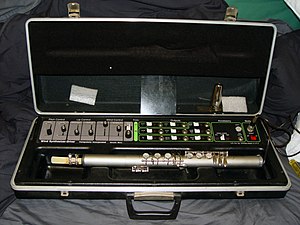Lyricon
Template:Reimprove The Lyricon is an electronic wind instrument, the first wind controller to be constructed.

(essentially, Lyricon II without synthesizer)
Invented by Bill Bernardi (and co-engineered by Roger Noble and with the late Lyricon performer Chuck Greenberg[1][2]), it was manufactured by Computone Inc. in Massachusetts in the early 1970s. The Lyricon was available in two designs, the first being somewhat silver and resembling a soprano saxophone and the latter, black and resembling an alto clarinet. Using a form of additive synthesis, the player was allowed to change between types of overtones with a key switchable between fundamentals of G, Bb, C, Eb, and F (allowing the instrument to be used to play transposed parts written for saxophones, trumpets, etc.) and an octave range that could be switched between low, medium, or high. The instrument also had controls for glissando, portamento, and "timbre attack" (a type of chorusing). The Lyricon used a bass clarinet mouthpiece, with a sprung metal sensor on the (non-vibrating) reed that detected lip pressure. Wind pressure was detected by a diaphragm, which moved and changed the light output from an LED, which was in turn sensed by a photocell to give dynamic control.
Two additional re-modelled Lyricons were engineered later. First the "Wind Synthesizer Driver", which had control voltage outputs for lip pressure, wind pressure and pitch, to control the VCA and VCF and pitch of an external analog synthesizer. Then the "Lyricon II" was engineered, which included a two-oscillator synthesizer. All the Lyricons used the same saxophone style fingering system, with two octave keys above the left-hand thumb rest. The Wind Synthesizer Driver and the Lyricon II also had a transposition footswitch feature, where a foot pedal could be used to transpose the entire range up or down one octave. None of the Lyricons were engineered to use MIDI (which was invented after Computone went out of business in 1980), although external MIDIfication modules were produced by JL Cooper and STEIM.
The design of the Lyricon controller was later borrowed to form the basis for Yamaha's WX-series MIDI wind controllers.
Prominent lyriconists
- Ian Anderson
- Jay Beckenstein
- Richard Elliot
- Kenny G[2]
- Chuck Greenberg
- Steve Jolliffe
- Roland Kirk
- Michał Urbaniak
- Yusef Lateef
- Andy Mackay
- Bennie Maupin
- Dan Michaels
- Lenny Pickett
- Jonas Kullhammar
- Courtney Pine
- Raphael Ravenscroft
- David Roach
- Tom Scott[2]
- James Senese
- Wayne Shorter[2]
- Bruno Spoerri
- Pedro Eustache
- John L. Walters[2]
- Charles "Prince Charles" Alexander
- Chris Wood
References
Notes
- Greenberg, Joy (2006) "A Pause in the Rain" ISBN 1-60145-018-4
- Ingham, Richard (1998) The Cambridge Companion to the Saxophone ISBN 0-521-59666-1
- ‘The Search For Expression’ by John L. Walters Sound on Sound magazine, September 1987
External links
- Demonstration video including very good audio samples
- David O'Brien official Lyricon repair
- Jorrit Dijkstra on the Lyricon
- Article on the Lyricon by Peter Holstlin
- The Lyricon at obsolete.com
- The Wind Controller FAQ
